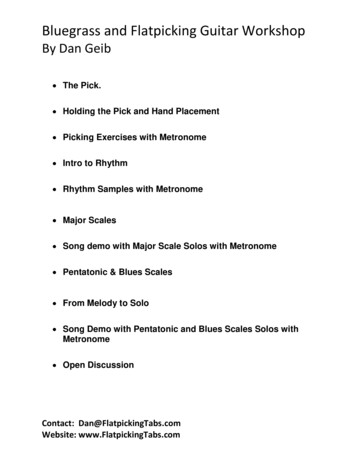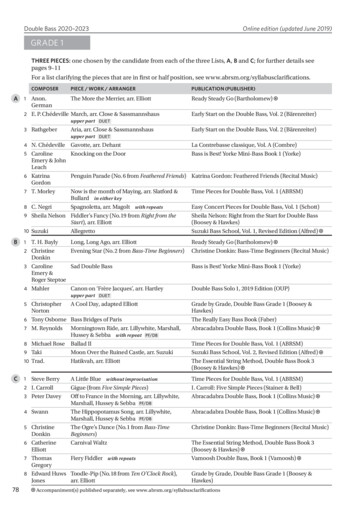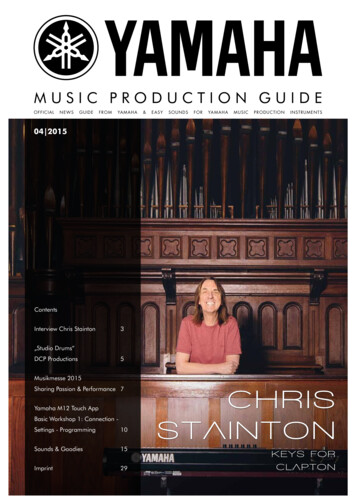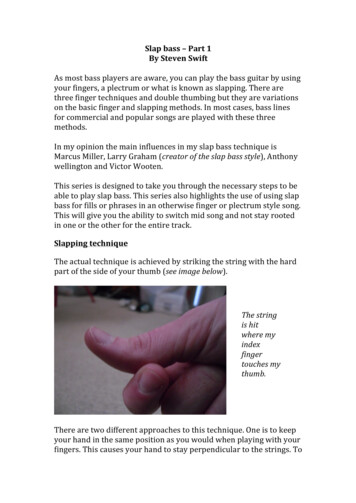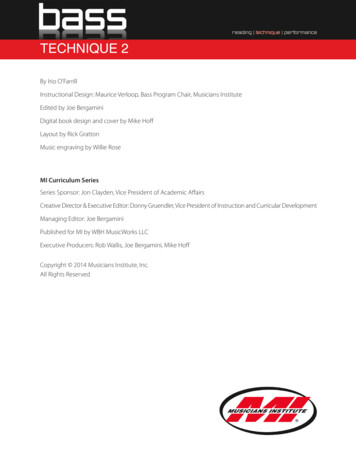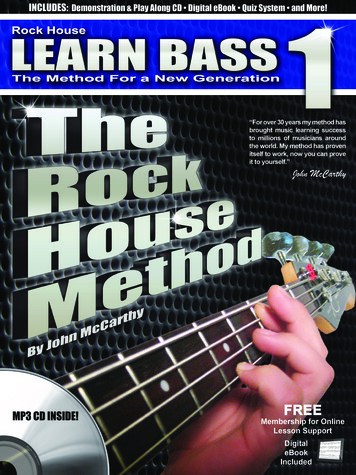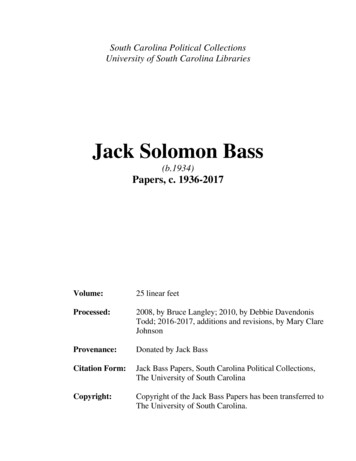
Transcription
21st CENTURY EDITION2Bluegrass BassByNed Alterman & Ritchie MintzFeaturing:Missy Raines Mark Fain Tom Gray Marshall Wilborn Byron HouseJere Cherryholmes Wayne Taylor Roger Bush Ruth McLainBenny Galloway Jack Cooke Randy Davis
ContentsAcknowledgments and Credits .2CD Personnel .2Photo Credits.2Copyrights.2Contents .3Preface to the 21st Century Edition .6A Magic Moment .7Forward .10Tuning .12How To Read Bass Clef Music Notation.16Rhythm.17How To Read Bass Fiddle Tablature (TAB).19TAB and Rhythm .21The Right Hand.22Beginning To Play.25Little Birdie .26Will The Circle Be Unbroken?.28Interview With Randy Davis.30The Left Hand .31Introduction To Closed Positions.35Scales .36Chromatic Scales .36Major Scales.38The C Major Scale .38Roots, Octaves and Fifths .40The G Major Scale .41The D Major Scale .42The A Major Scale .43Interview With Tom Gray.44Interview With Wayne Taylor.47More About Chords and Scales .50The Major Triad 1-3-5 .50Minor Chords .50Ragtime Annie.51Soldier’s Joy & Whiskey Before Breakfast .53Life’s Railway to Heaven .54Interview With Jere Cherryholmes .56The Bb Major Scale .62Arpeggios .63The B Major Scale .63The E Major Scale .66Interview with Byron House .67Major and Minor .73Foggy Hill Backstep.73Wabash Cannonball 742
The F Major Scale and Arpeggio .76Chart of Roots, Thirds and Fifths: Key of F Major.77Billy in the Lowground .78Summary of Major Scales.80Interview with Mark Fain .81Chord Progressions .84The Nashville Numbering System .84The Blues Progression: I – IV – V .84Sacred Progressions .84The Salty Dog Progression: I –VI – II – V – I .85Salty Dog. 87Don’t Let Your Deal Go Down . 88The Little Maggie Progression: I -VIIb.89Little Maggie.90Old Joe Clark.91June Apple.92Songs In Keys of E, Bb, and B.93Roll On, Buddy.93Blue Ridge Cabin Home.94Whitehouse Blues .96Interview with Benny Galloway.97Fifths, Octaves and Thirds .97Fingerboard Positions .97Bass Runs and Bass Lines.99Bass Runs.99The I-IV Progression.99The IV-I Progression.99The I-V Progression .100The IV-V Progression .100The I (or VIII) to VIIb Progression .101The I-II Progression .101The I–VI–II–V–I Progression.102In C.103In F .103In G .104Using the Flatted Seventh .105Blues and Boogie-Woogie .107Major Blues Line .107Minor Blues Line .109The Boogie-Woogie Walking Bass Line .112Interview with Missy Raines.115Interview with Marshall Wilborn.120Slap Bass Techniques .125The Single Slap .125The Double Slap .125The Triple Slap .126The Slack Tuned E-String.126The Reverse Rhythm Slap.127The “Boom-a Boom-a” Technique .1273
Interview with Roger Bush .129Interview with Ruth McLain.132Waltz Time .134All the Good Times and Amazing Grace.135Playing Backup and Soloing in 4/4 Time .137Alabama Jubilee.138Alabama Jubilee (Version 1).139Alabama Jubilee (Version 2).141Bass Solo: My Grandfather’s Clock .142Grandfather’s Clock – Bass Solo Part A .142Grandfather’s Clock – Bass Solo Part B .144Grandfather’s Clock – Bass Solo Part C.145Higher Octaves and Playing Up the Neck .146Higher Octave C Scale .146Playing in a Band .148Time .148Tune .148Tone .149Taste.149Listen.149Keep Learning.149Stage Presence for Bass Players.149Smile, Shine, Have a Good Time.149Movement Creates Interest .150Look Alive .150Be the MC .150Appendix and Misc. .152Bass Selection .152Bass Setup.153Setting the Bridge.154Setting the Sound Post .154Other Choices, Other Voices: Different Kinds of Basses .157Tributes to Junior Huskey and Roy Huskey Jr.158Towne and Country Revue: Live at MountainearsSong Charts and Commentary .160CD Liner Notes .169Reviews.170About the Authors.168Links & Resources .171This folio consists of pages from different sections of thebook, presented together as a “sample chapter” forillustrative purposes.4
Preface to the 21st Century EditionIn the 1970’s, a company called Oak Publications, a division of Music Sales Corporation, published aseries of “how to play” music instruction books for the emerging bluegrass/newgrass/folk players of theday. The books included Bluegrass Banjo and The Bluegrass Songbook, by Pete Wernick, BluegrassMandolin by Jack Tottle, Bluegrass Guitar by Happy Traum, Bluegrass Fiddle by Gene Lowinger,Bluegrass Dobro by Stacy Phillips, Melodic Banjo by Tony Trischka, and (lest we forget) Bluegrass Bassby Ned Alterman and Ritchie Mintz, originally published in 1977.They were all good books, most of them written by well-known players and performers, and generationsof bluegrass pickers learned how to play from them. They were, in fact, among the first instruction booksdedicated exclusively to bluegrass music, and they were among the first music instruction books tofeature TAB. They were also among the first music instruction books to come with stereo records inside.Remember those 33 ⅓ “floppy” vinyl records you’d tear out and play on your turntable? They weren’texactly high tech, but they worked.In the 1980’s, the business of publishing music instruction books was changing fast. Everyone with a TVeither had or was planning on getting a VCR, and music instruction books were rapidly losing theirmarket share to instructional videos. Music publishers and distributors adapted to the changing times bycarrying fewer titles, and Music Sales Corporation was no exception. When the last copy of BluegrassBass was sold in 1990, the decision was made not to reprint it, and Bluegrass Bass became officially “outof print.”In the 21st Century, it’s a whole new digital world. Instructional DVD’s exist for practically anything youcould possibly want to learn, and not surprisingly, DVD’s are especially well suited to teaching andlearning how to play music. In today’s music instruction DVD’s, the picture and sound quality arefantastic and your teacher is often one of your favorite performers. Also, the digital format enables splitscreen images, angled views, close-ups, slow-mo’s, fast forwards and “how’s that again?” repeatsavailable in seconds at the touch of a button. It’s like having an infinitely patient teacher who never getstired of teaching you things over and over again, shows you enough amazing stuff in an hour to keep youbusy for a year, only charges you once, doesn’t care if you’re late, and never asks if you’ve practiced!How cool is that?In this new 21st Century Edition of Bluegrass Bass, the original book has been revised, edited andexpanded with many new color pictures and 21st century updates. You’ll find new interviews with suchmodern bass stars as Mark Fain, Marshall Wilborn, Byron House, Jere Cherryholmes, and Missy Raines,to name just a few. Audio-wise, there are two CD’s included: The old floppy soundsheet record has beendigitally re-mastered and turned into a great new play-along CD with all the tracks from the originalrecording, now happily noise free and in perfect tune. In addition, the authors’ award-winning CD Towne& Country Revue: Live at Mountainears has also been included, along with complete song charts, playingtips and commentary for all 14 tunes.Coming soon is Bluegrass Bass, The Movie, our “work in progress” DVD that’s part entertainment andpart instructional video. On the DVD, which you’ll be able to view online and download, you’ll find moreentertaining interviews with great modern players, plus clips from live performances with instruction andcommentary by the artists themselves and picture-in-picture close-ups of how they play. Stay tuned to ourwebsite www.PickinRanch.com for information on Bluegrass Bass, The Movie.We’re proud and excited to present to you the new 21st Century Edition of Bluegrass Bass. We wish yougreat success in your pursuit of music, and we hope you have a ton of fun playing Bluegrass Bass.Ned and Ritchie5
ForwardThe upright bass what a fantastic instrument! It has the ability to enhance any kind of music, and isalways a welcome addition to any musical combination. In the world of bluegrass and folk music, banjopickers and guitar players seem to abound, but there never seem to be enough bass players. For thisreason, the bass makes an ideal second instrument, especially for guitarists. In fact, guitar players canexpect many “ah-hah” moments as they go through this book, because it’s also about the bass strings ofthe guitar. But any musician will gain valuable musical insights through study of the bass.In this book, we begin by assuming you know nothing about music. But if you can render a simple scale –DO, RE, MI, etc, (at least in your mind) – you will have a good jump on things. First off, you’ll learnseveral different but related ways to tune your bass and you’ll begin immediately to play songs on openstrings. And it’s so easy it can be done literally with one hand! We’ll proceed from that point in a logicalseries of steps designed to build important skills, with the hope that soon you'll be ready to play good,solid bass along with other pickers, and with your favorite recordings, too.Everyone knows it takes time and practice to learn how to play music, so it may come as a surprise to youto learn that the bass fiddle, at least as played in folk and bluegrass music, is not as difficult as otherinstruments. In bluegrass, the chord changes tend to be similar from song to song, and are usuallypredictable. The bass runs used to connect chords are also relatively simple and easy to learn. So even ifyou're a complete beginner, you can become a competent bass player in a relatively short period of time.Success is within anyone’s grasp. There are many bluegrass bassists who do little more on theirinstruments than what we show you in the beginning – rocking back and forth on open strings. A step upfrom that level are bassists who play in closed positions and connect the chord changes with melodic bassruns. And a bass player who happens to know some “slap bass” techniques can have an audience yellingfor more in short order!The development of good rhythm, accurate pitch, and ease of playing may take you a while, but as theysay, getting there is half the fun. If you keep at it, you will experience exciting breakthroughs.Everything you’ll need to know is here – where to put the fingers and why, exercises for both right andleft hands, theory, scales, chords, progressions, bass runs, walking bass lines, slap bass techniques, solos –and it’s all clearly illustrated. Bass parts are presented in easy-to-read TAB as well as in standard musicnotation (bass clef). There are lots of good tunes to learn and play and tracks to pick along with on theaccompanying CD's, plus information on important related subjects like how to select a bass fiddle, howto set it up for easy playing, how to use an electronic tuner to place side position markers, tips on playingin a group and much more.But a book can only go so far. When you run into a bass teacher, or even a friendly picker who wouldn’tmind showing you a few things, grab the chance! A few lessons can take you a long way on bass, and canbe a valuable addition to what we teach you in this book.We extend to you a hearty welcome to the Pickin’ Ranch Bluegrass Band.Thanks for showing up for the audition. We’ve been expecting you.You have a bass, right?Good. In that case, you passed the audition.You’re the new bass player and it’s time to pick!Ready?Let’s tune up.6
The Right HandThe picture below illustrates good right-hand position for pizzicato (plucking) style.Your right handposition will probably be somewhat different. Good tone depends not only a good sounding bass, but alsoon a good setup and good strings. But there is much more to good playing than that. We can’t adequatelyinstruct you about hand and body positions because our hands and bodies are all different, and whatworks for one bass player won’t always work for another. What we can do is give you some good advice,and that is to seek out bassists whose playing you admire, and take some lessons from them. Just a fewlessons can make a huge difference.Behold the right hand of amaster player, jazz bassistPaul Spikes. There is much tolearn from studying thispicture, so take your time.Look closely. Note the gentleangle from the forearmthrough the wrist to the hand.This picture is filled with theenergy of relaxed strength.Can you sense it? You can seeit in the hand and the way thefingers touch the strings.Although you can’t actuallysee the palm side of Paul’shand, try to imagine what itmight look like. Focus yourattention on Paul’s fingers,especially the index andmiddle fingers. Notice howmuch of each finger comes in contact with the strings. There’s a long callous line on the underside of eachfinger right where the string is. If you could see those calluses, they would tell you a lot about how Paulplays. What do those calluses have to teach you? Try and see them in your imagination. How many songsdo you think this hand has played? How many notes?Paul Spikes gets a big, warm sound out of his gorgeous Pollmann carved bass, but he never strikes violentblows. He plays wonderfully well with a light, authoritative touch.Body posture is important. How you stand in relation to the bass affects your right hand position and theway your fingers pluck the strings, and that affects everything.Let’s digress for a moment and talk about the endpin. Most bassists wouldn’t dream of playing withoutfirst extending the endpin. Try different endpin settings and choose a comfortable height setting for yourbass. A good starting point would be with the string nut (up by the tuners) about even with the top of yourhead. Preferences vary. Classical and jazz bassists (and those with similar training) like higher settings tofacilitate bowing and good left hand technique and also to provide easy access to the higher octavepositions. Bluegrass and folk musicians tend to like somewhat lower settings. While we’re on the subject:Don’t forget to securely hand tighten the endpin screw. (You wouldn’t want any gravitational surprises.)And remember to check the protective rubber tip on the endpin once in a while to make sure it hasn’tworn through. It’s a good idea to carry a spare.7
Right: The thumb of the right hand is an important digitfor bass players. It’s usually positioned for pullingleverage at the side edge of the fingerboard. Theplacement of the thumb varies from player to player. Ifyou are attentive to wrist position and the direction theindex and middle fingers take as they approach thestrings, the thumb will naturally find its best location. Inthe photo at right, the camera has caught the hand inmotion. Notice the positions of the index and middlefingers. Paul Spikes appears to be plucking the G-stringwith his middle finger. What’s the index doing?Left: Colorado bassist PaulWaitinas’ right hand looksrelaxed and ready. The indexfinger is positioned on the Gstring with the tip of the fingerextending past the string.Right: Paul shows howhe positions his thumb behindthe fingerboardfor good pulling leverageon the E-string.Left: After plucking the D-string,the index comes to rest on theadjacent A string.8
Beginning To PlayWith the bass in tune to standard pitch, we can begin by playing a song or two straight off. We'll startwith Little Birdie, a traditional American folk song. The job of the bass is to keep time by striking thestrings in a steady rhythm. On the recording, the bass is heard through the right channel only, so you cantune it in or out as you wish.To play bass for Little Birdie, you’ll need two chords, G and D, and for each chord you’ll rock back andforth between two notes.There is no need to employ the left hand for this tune. Just pluck the open strings with the index finger ofthe right hand.The G ChordThe D ChordStriking the open G-stringfollowed by the open D-string.Striking the open D-stringfollowed by the open A-string“The bass player needs to view his instrument and what he does on itin light of what’s going on in the song. Listen to the song, don’t just listen to yourself.”-Jere Cherryholmes9
Will The Circle Be Unbroken?TraditionalTrack 3Key: D10
V.1I was standing by my window,On one cold and cloudy day.When I saw that hearse come rollin',For to carry my mother away.V.2Oh I told that undertaker,Undertaker, please drive slow.For the lady you’re a-haulin',Lord, I hate to see her go.V.3Oh I followed close behind her,Lord, I tried to be so brave.But I could not hide my sorrow,When they lowered her into the grave.V.4I went home, Lord, my home was lonely,Since my mother she was gone.All my brothers, sisters crying,In a home so sad and alone.Circle Playing TipsWill the Circle Be Unbroken? is a classic folk/bluegrass/gospel song.In Little Birdie, we were playing in the key of G. The term key is defined more fully in later chapters, butfor now, think of it this way: Our starting point for Little Birdie was a G chord, and our ending up pointwas also G.G was the "home" chord, also called the I chord, so the tune was in the key of G.Circle is in the key of D, so our home chord will be D. There’s a chord change from D to G (aka the IVchord) in the second line and a return to D (I) at the end of the line.GDbye and bye, Lord, bye and bye.There’s another similar change in the last line of the verse/chorus, except it goes from D (the I chord) toA (the V chord), which you just learned, and then back to D:DADIn the sky, Lord, in the skyThis I-V-I change in the last line of the verse or chorus is typical of thousands of bluegrass and folk tunes.The Roman numerals are used as generic one-size-fits-all designations for chord changes, regardless ofthe song or key. For example, in Little Birdie, you played two chords - G and D. Just count up thealphabet from G to D, with G as note number 1 and D as note number 5. (Yep, you guessed it – it’sanother one of them there I-V chord progressions.)You will find it helpful if you listen to the CD track (Track 3) first. The bass is heard in the right channel,while the rest of the band and the vocals are heard in the left. You can adjust either channel up or down asyou wish. As you listen to the track, follow along in the music and TAB so the change to th
Everything you'll need to know is here - where to put the fingers and why, exercises for both right and left hands, theory, scales, chords, progressions, bass runs, walking bass lines, slap bass techniques, solos - and it's all clearly illustrated. Bass parts are presented in easy-to-read TAB as well as in standard music notation (bass clef).
